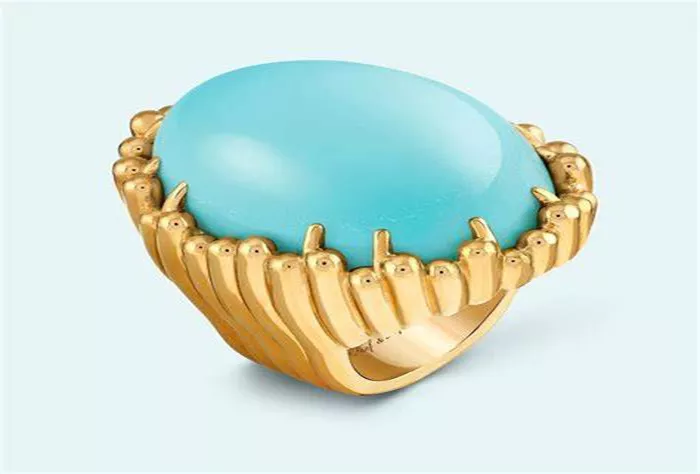Turquoise has been a highly prized gemstone for centuries. When set in rings, turquoise pieces can often command high prices. There are several factors that contribute to the relatively high cost of turquoise rings. These include the rarity of high – quality turquoise, its historical and cultural significance, the mining and production process, and the quality factors related to the gemstone itself.
Rarity of High – Quality Turquoise
Geological Occurrence
Turquoise is formed in a specific geological environment. It is a secondary mineral that typically forms in arid regions where copper – rich solutions interact with aluminum – bearing rocks. High – quality turquoise deposits are not widespread. For example, some of the most renowned sources like the Sleeping Beauty mine in Arizona (now closed) produced turquoise with unique and desirable characteristics. The scarcity of these deposits means that obtaining high – quality turquoise for ring making is not easy.
Quality Variation
The quality of turquoise can vary greatly. Only a small percentage of mined turquoise meets the high – quality standards required for fine jewelry. High – quality turquoise has a consistent color, a fine texture, and few inclusions. Much of the mined turquoise may be of lower quality, with color variations, matrix (host rock) inclusions that are too prominent, or a chalky texture. The rarity of the high – quality material drives up its price when used in rings.
Historical and Cultural Significance
Ancient Use
Turquoise has a long and rich history of use in different cultures. In ancient civilizations such as the Egyptians, Native Americans, and Persians, turquoise was highly valued. It was used in religious and ceremonial objects, as well as in jewelry. For example, Native American tribes have a deep connection to turquoise, believing it to have spiritual and protective properties. This historical and cultural significance adds value to turquoise rings. People are often willing to pay more for a gemstone that has such a storied past.
Artistic and Symbolic Value
Turquoise has also been an important material in the world of art and jewelry design. Its unique color, ranging from sky – blue to greenish – blue, has inspired countless artists and jewelers. In addition, it has been associated with various symbols and meanings, such as protection, good luck, and a connection to nature. Rings featuring turquoise can carry these symbolic values, making them more desirable and, consequently, more expensive.
Mining and Production Process
Mining Challenges
The mining of turquoise can be a difficult and costly process. Many turquoise deposits are located in remote areas, which can make access and extraction challenging. The extraction methods need to be carefully controlled to avoid damaging the delicate turquoise. For example, in some mines, turquoise is found in small veins or pockets within the host rock, requiring precise extraction techniques. This adds to the cost of obtaining the raw turquoise material for ring production.
Treatment and Enhancement
A significant amount of turquoise undergoes treatment or enhancement processes. These can include processes like stabilization to improve its durability. While treated turquoise is more common in the market, untreated high – quality turquoise is highly prized and more expensive. The treatment processes themselves add costs to the production chain. Also, ensuring that the treatment is properly disclosed and compliant with industry standards is an important aspect of the production process, which also affects the overall cost.
Quality Factors Related to the Gemstone
Color
Color is a crucial factor in determining the value of turquoise for rings. The most desirable colors are a vivid sky – blue or a pure blue without a greenish tint. The intensity and uniformity of the color play a significant role. A turquoise ring with a beautiful, consistent blue color will be more expensive. If the color is pale or has a lot of color zoning, its value will be lower.
Clarity
Although turquoise is not typically judged by the same clarity standards as transparent gemstones like diamonds, the presence of inclusions and the texture of the matrix matter. A turquoise with a relatively clean appearance, with few visible inclusions or a well – integrated matrix, is more valuable. If the inclusions are too prominent or the matrix makes the stone look chalky or of poor quality, the price of the turquoise ring will be affected.
Cut and Polish
The cut and polish of the turquoise in a ring also influence its price. A well – cut turquoise will enhance its color and appearance. The shape of the cut should be proportionate and smooth, and the polish should bring out the best in the stone’s color and texture. A poorly cut or unpolished turquoise will not be as visually appealing and will be less expensive.
Conclusion
In conclusion, the expense of turquoise rings can be attributed to multiple factors. The rarity of high – quality turquoise, its historical and cultural significance, the challenges in the mining and production process, and the various quality factors related to the gemstone all contribute to its relatively high cost. Whether it is for its aesthetic appeal, its connection to history and culture, or its symbolic value, turquoise remains a valuable gemstone for use in rings, and consumers are often willing to pay a premium for well – made turquoise ring pieces.
Related topic:
- How Do Tanzanite, Zircon, and Turquoise Compare in Value?
- Amethyst vs. Turquoise: Which Gemstone for Your Ring?
- Handcrafted Eagle Turquoise Ring: Wear a Piece of Nature’s Art


